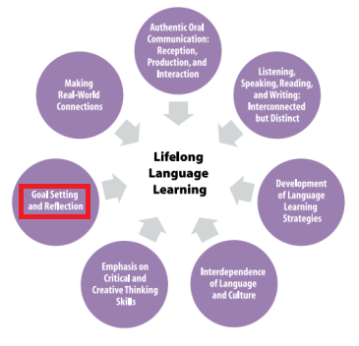Tags
assessment as learning, creativity, curriculum, FSL, goals, growth mindset, instructional practice, learning skills, metacognition, reflection, self-assessment
For the first official post in my blog series about transitioning to Ontario’s new FSL curriculum in my classroom, I begin with some context. I have been teaching in a secondary French Immersion program for almost three years. This semester is the first time I have had an FIF course on my timetable. During the first two and a half years, I taught the other courses in the program, such as Mathematics and Dramatic Arts, in French. Right now, I have two FIF2D courses and a PPL3OI (Co-ed Immersion HPE). I have been experimenting with aspects of the new curriculum in my two FIF2D classes and that’s where my reflections will be coming from.
Speaking of reflection, the new curriculum now has a metacognition expectation in each strand, and goal setting and reflection comprise one of the Enduring Ideas addressed in the front matter of the document. I spent the first two weeks of the semester simply engaging in diagnostic learning activities with my students. We listened to French (mostly through videos), had small and large group discussions in French, read two short stories in French, and wrote two short compositions in French. After these initial diagnostics addressing each strand, students consulted their feedback – written comments I had made on their work, assessment rubrics indicating their levels of achievement in various aspects of oral and written communication, and their own impressions of their strengths and growth areas. I then asked each student to set a small, specific goal for improvement. They each wrote their goal on a post-it note (in French of course), and stuck it to the wall of the classroom, so that all of our goals were visible and so that we could hold each other accountable. (Side note: writing goals was a great opportunity to review futur simple [“I will…”], futur proche [“I’m going to…”], and verb + infinitive [“Je veux faire/atteindre…”]).
At the end of February, I had a one-on-one oral interview with each student as an evaluation of their oral communication and as a check-in on their goal. Each student took their post-it off the wall that day and brought it with them to the oral interview. They were also given a self-assessment organiser with a short rating scale and some questions to guide their reflections about their progress over the first month (this tool was developed in conjunction with the French Immersion Department). During the interview, each student justified their choice of goal – why was it their choice, where did it come from – and then also explained what steps they had taken so far, and if they had been successful in achieving their goal.
Many students set a goal that was too large and complex to accomplish in two weeks, but all students had at minimum made progress towards their goal. This shows me that I need to be more purposeful about explicitly teaching goal-setting as a skill, as well as breaking down your big goals into smaller ones to make tracking progress simpler.
In addition to this multi-step process, I have been including reflection pieces at the end of evaluation tasks, a practice that I had already been using regularly, mostly from the influence of teaching Dramatic Arts and Physical Education where reflection and self-assessment occurs constantly. For example, we had a class debate on the topic of which educational program (French Immersion, IB, Coop, SHSM, etc.) is the best course of study. Following the debate (which occurred in teams), each student completed an individual written reflection discussing their personal opinion after hearing everyone’s arguments, which other students they found to be the most persuasive and convincing during the debate and why, and a self-assessment of their personal performance in the debate. Most students gave quite an honest appraisal of their level of achievement for the debate, and some were even more critical of themselves than I was.
Finally, I often ask students in all of my classes to self-assess when they are about to submit an evaluation. They take out their rubric (or grab a new copy from me) and either circle or highlight the levels of achievement they believe that they have demonstrated and submit this along with the task. Then I use a different colour pen or highlighter when I complete the evaluation. Sometimes I also have students complete a justification, either in writing or through a conversation. This works best when the rubrics have either been co-created with students, or are designed with clear student-friendly descriptors for each criterion.
If you are curious to see any assessment tools or the tasks that I have discussed in this post, please feel free to visit my class website at fif2d1i.wikispaces.com. What have you done in your classroom to promote metacognition, reflection, goal-setting, and student self-assessment? I’d love to hear ideas from other teachers, FSL or otherwise.
